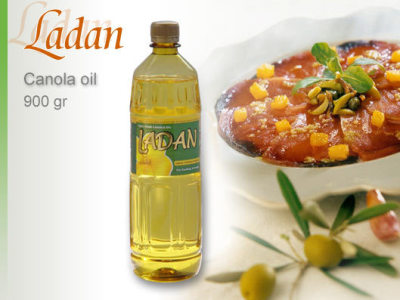Canola Oil
Advantages
Bad cholesterol (LDL) decrease in blood
Good cholesterol (HDL) increase in blood
Lowering blood triglyceride
Omega 3 and 6 rich source
Plaques accumulation decrease
Blood coagulation preventive effect
Heart attack preventing
Suitable for salads, cooking and mild temperature light frying
Fatty acid composition similar to olive oil
FDA recommended dietary oil for high blood fat disorder
Excellent balance between linoleic and linolenic acid contents
High oxidative stability due to 60% oleic acid content
More information
Canola oil is characterized by a very low level of saturated fatty acids, a
relatively high level of monounsaturated fatty acids and an intermediate level of polyunsaturated fatty acids, with a good balance between the omega-6 and omega-3 fatty acids. Canola oil
contains
only 7% saturated fatty acids; about half the level present in corn oil, olive oil and soybean oil and about one-quarter the level present in cottonseed oil.
The most abundant monounsaturated fatty acid in virtually all fats and oils is
oleic acid. Oleic acid makes up 58% of the total fatty acids in canola oil. Among the common vegetable oils, canola oil is second only to olive oil in oleic acid content. Studies over the past 15
years have shown dietary oleic acid is equally as effective in lowering plasma cholesterol level as dietary polyunsaturated fatty acids. Humans and other species are able to synthesize oleic acid so
it is not required in the diet; in other words, it is not an essential fatty acid.
Canola oil is intermediate among the vegetable oils in polyunsaturated fatty acid (PUFA) content. It contains appreciably higher levels of PUFA than palm oil or olive oil but lower levels of PUFA
than corn oil, cottonseed oil, safflower oil, soybean oil and sunflower oil. Interest in PUFA stems from their role as essential fatty acids and their effectiveness in lowering plasma cholesterol
level, a major risk factor in coronary heart disease. Linoleic acid has long been recognized as an essential fatty acid. Animals, including humans, are unable to synthesize it and, therefore, it is
required in their diets. However, they are able to convert linoleic acid to arachidonic acid and other members of the omega-6 family of fatty acids.
Arachidonic acid is important in membrane structures and is the starting material for the synthesis of “hormone-like” substances.
Recent studies have indicated that alpha-linolenic acid and other members of
the omega-3 family of fatty acids likewise are essential. Like, linoleic acid, linolenic acid can be converted to other members of the omega-3 family, namely, EPA and DHA. DHA is a major constituent
of lipids in the brain and the retina of the eye. Canola oil contains an appreciable amount (11%) of linolenic acid. Hence, there is a very favorable balance (approx. 2:1) between linoleic acid
(omega-6 PUFA) and linolenic acid (omega-3 PUFA) in canola oil.
The effectiveness of canola oil in reducing plasma total and LDL cholesterol
levels and the observation that it may alter clotting activity and protect against cardiac arrhythmias indicate a beneficial role for canola oil as part of a nutritious diet.




